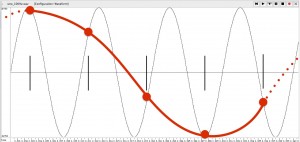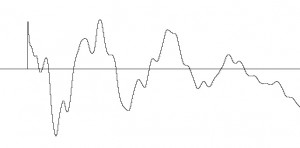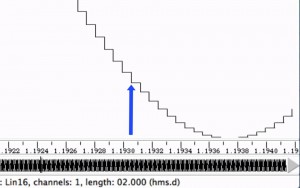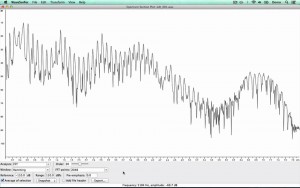The equation for entropy is very often presented in textbooks without much explanation, other than to say it has the desired properties. Here, I attempt an informal derivation of the equation starting from uniform probability distributions. A good way to think about information is in terms of sending messages. In the video, we send messages […]
A simple synthetic vowel
Using Praat, we synthesise a simple vowel-like sound, starting with a pulse train, which we pass through a filter with resonant peaks.
Pipeline architecture for TTS
Most text-to-speech systems split the problem into two main stages. The first stage is called the front end and contains many separate processes which gradually build up a linguistic specification from the input text. The second stage typically uses language-independent techniques (although they still require a language-specific speech corpus) to generate a waveform. Here we see those two […]
Aliasing
In sampling and quantisation we saw that sampling a signal at a fixed rate means that there is an upper limit on the frequencies that can be represented. This limit is called the Nyquist frequency. Before sampling a signal, we must remove all energy above the Nyquist frequency, and here we will see what would […]
Classification and regression trees (CART)
A quick introduction to a very simple but widely-applicable model that can perform classification (predicting a discrete label) or regression (predicting a continuous value). The tree is learned from labelled data, using supervised learning. Before watching this video, you might want to check that you understand what Entropy is.
Windowing
When we say that a signal is non-stationary we mean that its properties, such as the spectrum, change over time. To analyse signals like this, we need to first assume that these properties do not change over some short period of time, called the frame. We can then analyse individual frames of the signal, one at a […]
Sampling and quantisation
Is digital better than analogue? Here we discover that there are limitations when storing waveforms digitally. We learn that the consequence of sampling at a fixed rate is an upper limit on the frequencies that can be represented, called the Nyquist frequency. In addition to the limitations of sampling, storing each sample of the waveform as a […]
Spectrum and spectrogram
The spectrum and the spectrogram are much more useful ways of analysing speech signals than the waveform. We look at how to create them using Wavesurfer and what effect the analysis window size has on what we see.
My inaugural lecture
I talk about how speech synthesis works, in what I hope is a non-technical and accessible way, and finish off with an application of speech synthesis that gives personalised voices to people who are losing the ability to speak. I also try to mention bicycles as many times as possible. For a more up-to-date, slightly more technical, […]









 This is the new version. Still under construction.
This is the new version. Still under construction.